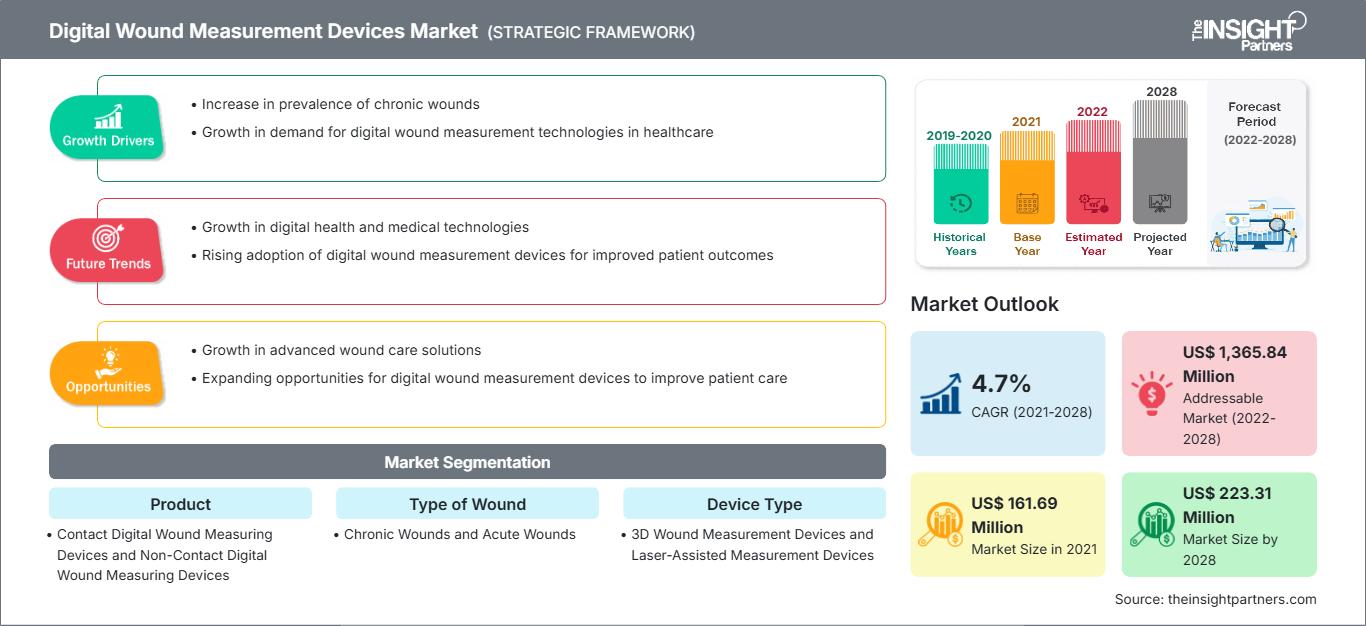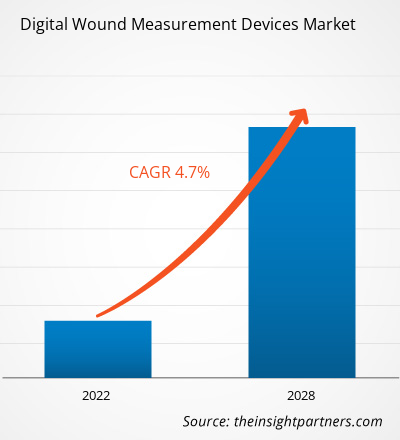[研究报告]数字伤口测量设备市场预计将从 2021 年的 1.6169 亿美元增长到 2028 年的 2.2331 亿美元;预计 2021 年至 2028 年的复合年增长率为 4.7%。
数字伤口测量设备市场根据产品、伤口类型、应用、设备类型、最终用户和地域进行细分。按地域划分,数字伤口测量设备市场大致分为北美、欧洲、亚太地区、中东和非洲以及南美和中美洲。本报告对市场进行了深入洞察,重点关注市场趋势、技术进步和市场动态等参数,并分析了主要市场参与者的竞争格局。
自定义此报告以满足您的要求
您将免费获得任何报告的定制,包括本报告的部分内容,或国家级分析、Excel 数据包,以及为初创企业和大学提供超值优惠和折扣
数字伤口测量设备市场: 战略洞察

- 获取本报告的主要市场趋势。这个免费样本将包括数据分析,从市场趋势到估计和预测。
您将免费获得任何报告的定制,包括本报告的部分内容,或国家级分析、Excel 数据包,以及为初创企业和大学提供超值优惠和折扣
数字伤口测量设备市场: 战略洞察

- 获取本报告的主要市场趋势。这个免费样本将包括数据分析,从市场趋势到估计和预测。
市场洞察
溃疡发病率上升显著促进市场增长
不健康生活方式、饮酒和吸烟的日益盛行导致非传染性疾病的患病率上升。例如,2018 年,世界卫生组织 (WHO) 表示,全球 18 岁及以上成年人中有 13% 肥胖。美国的肥胖患病率最高(约 42.4%),其次是沙特阿拉伯、土耳其、埃及、利比亚、伊朗、伊拉克、南非、加拿大、墨西哥、澳大利亚以及许多南美和欧洲国家。此外,截至 2018 年,糖尿病影响了 3420 万美国公民(占总人口的 10.5%)。糖尿病前期影响着 8800 万人,如果不及时治疗,五年内可能发展为 2 型糖尿病 (T2D)。糖尿病影响着 18 至 44 岁人群中约 4.2% 的人、45 至 64 岁成年人中约 17.5% 的人以及 65 岁及以上人群中约 26.8% 的人。因此,糖尿病足溃疡和压疮等糖尿病相关风险的上升正在扩大数字伤口测量设备的市场规模。此外,糖尿病相关并发症,例如糖尿病足溃疡 (DFU),也促进了对先进伤口护理管理产品的需求。例如,根据国际糖尿病联合会的数据,糖尿病患者需要小腿截肢的可能性是普通人群的 15 至 40 倍。约85%的截肢术后会发展为神经性足部溃疡。因此,这些因素在预测期内推动了对数字伤口测量设备的需求。
基于产品的洞察
根据产品类型,数字伤口测量设备市场分为非接触式数字伤口测量设备和接触式数字伤口测量设备。2021年,由于技术进步以及该设备能够有效且非接触式地测量伤口表面积和体积,非接触式数字伤口测量设备细分市场占据了更大的市场份额。
基于伤口类型的洞察
根据伤口类型,数字伤口测量设备市场分为慢性伤口和急性伤口。慢性伤口进一步分为压疮 (PU)、糖尿病足溃疡 (DFU)、腿部静脉溃疡 (VLU) 和动脉溃疡。急性伤口进一步分为烧伤和创伤以及手术伤口。2021 年,慢性伤口部分占据了更大的市场份额。这归因于压疮、糖尿病足溃疡、腿部静脉溃疡和动脉溃疡等慢性伤口发病率的上升。
基于设备类型的洞察
根据设备类型,数字伤口测量设备市场分为 3D 伤口测量设备和激光辅助测量设备。激光辅助伤口测量设备部分在 2021 年占据了更大的市场份额;预计在预测期内,市场复合年增长率将更高。
基于应用的洞察
根据应用,数字伤口测量设备市场细分为伤口护理、肢体保存和重建手术。伤口护理部分进一步细分为血液灌注、高压氧疗法、组织活力等。慢性伤口部分在 2021 年占据数字伤口测量设备市场的最大份额。然而,预计在预测期内,伤口护理部分将在数字伤口测量设备市场中实现最高的复合年增长率。
基于最终用户的洞察
根据最终用户,数字伤口测量设备市场分为医院和诊所以及社区中心。医院和诊所部分在 2021 年占据数字伤口测量设备市场的较大份额;预计在预测期内,数字伤口测量设备市场将实现更高的复合年增长率。
产品发布、合并和收购是全球数字伤口测量设备市场参与者高度采用的策略。以下列出了一些近期的关键市场发展:
2021 年 9 月,Kent Imaging 宣布加拿大卫生部批准 SnapshotNIR V3.0 (KD204),现已提供两种官方语言版本。此次升级显著增强了成像技术的功能,从而促进了急性和慢性伤口的组织评估。
数字伤口测量设备 — 市场细分
根据产品,数字伤口测量设备市场分为接触式数字伤口测量设备和非接触式数字伤口测量设备。根据伤口类型,市场分为慢性伤口和急性伤口。慢性伤口细分市场进一步细分为压疮 (PU)、糖尿病足溃疡 (DFU)、下肢静脉溃疡 (VLU) 和动脉溃疡。急性伤口细分市场进一步细分为烧伤和创伤以及手术伤口。根据设备类型,数字伤口测量设备市场分为 3D 伤口测量设备和激光辅助测量设备。根据应用,数字伤口测量设备市场细分为伤口护理、肢体保存和重建手术。伤口护理细分市场进一步细分为血液灌注、高压氧疗法、组织活力和其他。根据最终用户,数字伤口测量设备市场细分为医院和诊所以及社区中心。根据地域,市场主要细分为北美、欧洲、亚太地区、中东和非洲以及南美洲和中美洲。
数字伤口测量设备市场区域洞察
The Insight Partners 的分析师已详尽阐述了预测期内影响数字伤口测量设备市场的区域趋势和因素。本节还讨论了北美、欧洲、亚太地区、中东和非洲以及南美和中美洲的数字伤口测量设备市场细分和地域分布。
数字伤口测量设备市场报告范围
| 报告属性 | 细节 |
|---|---|
| 市场规模 2021 | US$ 161.69 Million |
| 市场规模 2028 | US$ 223.31 Million |
| 全球复合年增长率 (2021 - 2028) | 4.7% |
| 历史数据 | 2019-2020 |
| 预测期 | 2022-2028 |
| 涵盖的领域 |
By 产品
|
| 覆盖地区和国家 | 北美
|
| 市场领导者和主要公司简介 |
|
数字伤口测量设备市场参与者密度:了解其对业务动态的影响
数字伤口测量设备市场正在快速增长,这得益于终端用户需求的不断增长,而这些需求的驱动因素包括消费者偏好的不断变化、技术进步以及对产品优势的认知度不断提高。随着需求的增长,企业正在扩展产品线,不断创新以满足消费者需求,并抓住新兴趋势,从而进一步推动市场增长。

- 获取 数字伤口测量设备市场 主要参与者概述
公司简介
- eKare Inc.
- Kent Imaging Inc.
- WoundMatrix Inc.
- Perceptive Solutions
- WoundVision
- Aranz Medical Ltd.
- Tissue Analytics
- Fuel 3D Technologies Ltd.
- Hitachi Aloka Medical America Inc.
- MolecuLight Inc.
- 历史分析(2 年)、基准年、预测(7 年)及复合年增长率
- PEST和SWOT分析
- 市场规模、价值/数量 - 全球、区域、国家
- 行业和竞争格局
- Excel 数据集
近期报告
相关报告
客户评价
购买理由
- 明智的决策
- 了解市场动态
- 竞争分析
- 客户洞察
- 市场预测
- 风险规避
- 战略规划
- 投资论证
- 识别新兴市场
- 优化营销策略
- 提升运营效率
- 顺应监管趋势




















 获取免费样品 - 数字伤口测量设备市场
获取免费样品 - 数字伤口测量设备市场